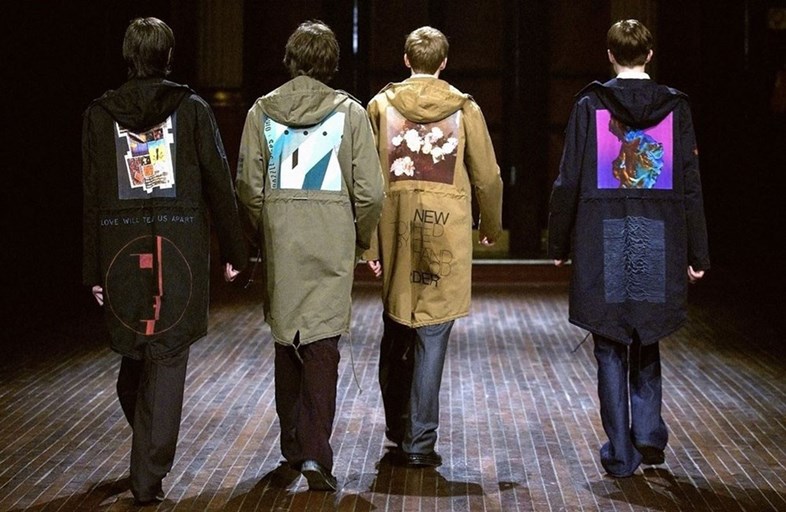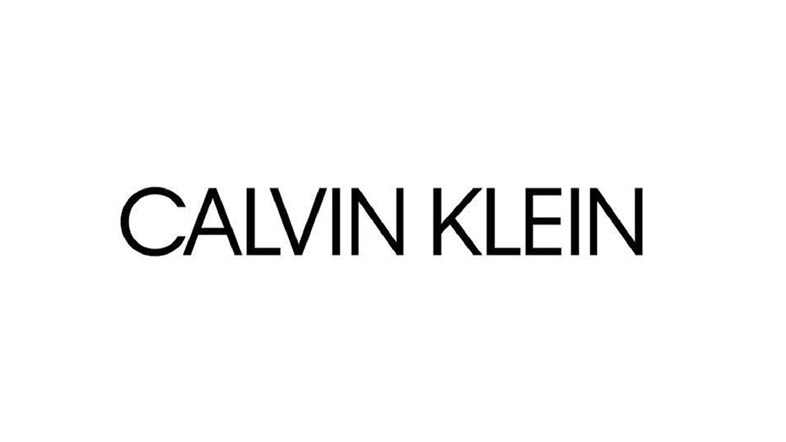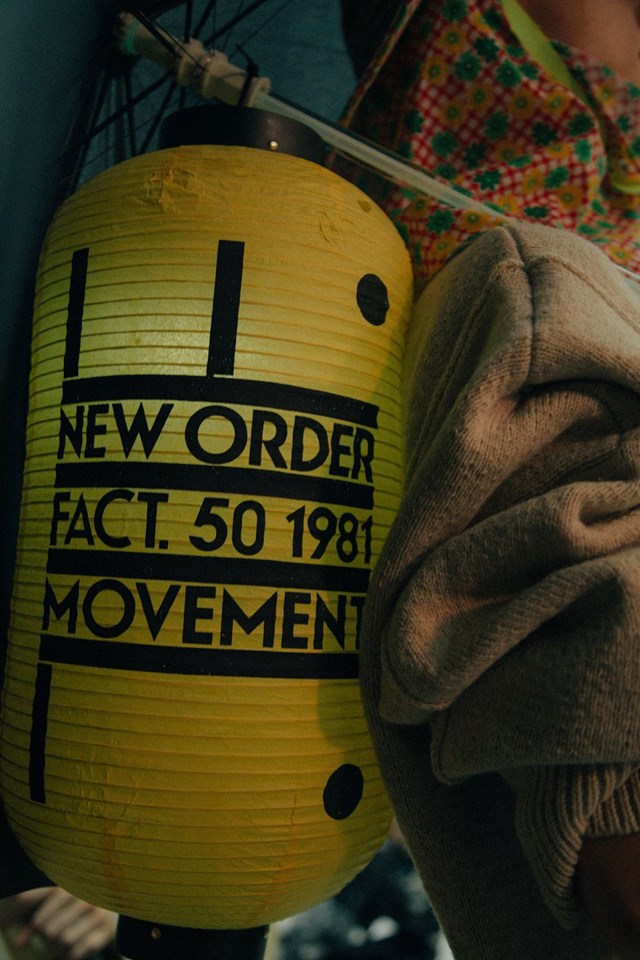As Raf Simons calls upon Peter Saville’s archive of record artwork for his S/S18 collection, we look back on almost 20 years of their creative collaborations
- TextCalum Gordon
The old adage is that you should never meet your heroes. Raf Simons, of course, has never been one particularly enamoured with conventional ideals.
For Simons, famed English graphic artist Peter Saville was not only an early hero – it was the enticing otherness of the record covers Saville designed which first exposed the Belgian to the strange, radical sounds emanating from Manchester at that time – but he was also somebody Simons sought to collaborate with. Despite hailing from two decidedly different parts of the world – Simons from the sleepy town of Neerpelt in Belgium, and Saville from Manchester, England – the duo share a decidedly modernist outlook on culture. This outlook has, in turn, spawned one of the most unique and intriguing collaborative relationships in fashion.
Here, we take a look at nearly two decades of creative endeavours between the two, and examine Simons’ for not only meeting your heroes, but working with them too.
Early inspiration
It may seem odd that Peter Saville’s exacting brand of austere moodiness, which he practised while working for Factory Records in the late 70s and 60s, could serve as a form of escapism. But for a young Raf Simons, who grew up in a town disconnected from anything that could remotely be deemed a cultural hotspot, Saville’s cover artwork for the likes of New Order and Joy Division proved to be exactly that.
“One of the first things I picked up when I was very, very young out of a record store was work from Peter Saville - the early things he used to do for Factory Records,” he told The Talks in 2013. “I come from a village of 6,000 people, so forget about Berlin, London, New York – what are you talking about? – I didn’t know anything. So I picked up things because of the imagery. We have to think back in time – no computers, no mobiles, no nothing – it was pure isolation in a way.”
While not exactly a collaboration between the two, it left an irrevocable impression on Simons, and would go on to inform much of his early work – with themes of isolation and angst, punctured by youth culture and the transformative power of music and art featuring regularly.

Raf Simons A/W03
Belgian iconoclast Simons has produced many memorable collections in a career spanning over two decades, but one in particular seems to be fixated on by fans and fashion journalists alike. Simons’ A/W03 collection, which saw his first formal collaboration with Peter Saville, incorporated many of the record sleeves and motifs of the Englishman’s work at Factory Records, from Joy Division’s enduring Unknown Pleasures cover to more subtle accents, like the ‘F’ logo of the band’s record sub-label, which adorned the sleeves of the mod-style parkas that were shown. Today, those parkas can fetch up to tens of thousands of pounds on reseller websites.
It is hard to pinpoint exactly why this single collection seems to have superseded all others in terms of modern-day relevance. Perhaps it is because it was the ultimate pop culture collaboration, as Saville’s iconic visual accompaniments to the post-punk era clashed with Simons’ idiosyncratic stylings. While that collection is nearly 15 years old, and the artwork used within it closer to 40, there is something to be said for the fact that both look decidedly current – two expressions of youth culture, both of which have somehow become timeless.

Calvin Klein
Perhaps out of a desire that Calvin Klein be known as a fashion brand first and foremost, if one that happens to create underwear too, a newly appointed Simons wasted little time in attempting to rework the brand’s image. His first port of call? To have the brand’s iconic logo redesigned. Naturally, he enlisted the help of Saville, who, post-Factory, has worked with everyone from the English Football Association to Kanye West. The resulting sleek, minimal replacement acts as a signal of intent from Simons, but it also underlines the duo’s commitment to making their work clear and impactful.

Raf Simons S/S18
There has been an apparent tension in Simons’ work over the past few years, as he reckons with his own legacy and place in the zeitgeist. A/W15 saw him declare that his “archives were no longer relevant,” while his S/S17 collection, shown in Florence, was set in a room filled with archive pieces. Earlier this year, in an interview with GQ, he described the current and pronounced fascination with his earlier work (in particular A/W03) as “weird to experience.”
This past week in Chinatown, New York, we witnessed Simons’ latest musings on the subject, as he once again called upon Saville and incorporated many of the record artworks from A/W03 into the S/S18 collection. “I wanted to go to where I was in the beginning. With references to the youth who create their own looks, like punks and new wave and new romantics,” he said of this latest collaboration. “But in a more extreme way. More linked to my own past.”
Some ten days prior in Manchester, the art exhibition True Faith opened, examining “the ongoing significance and legacy of New Order and Joy Division”. Naturally, it included one of the prized parkas from Simons’ 2003 hook-up with Saville, featuring the graphic artist’s subtle edit of Henri Fantin-Latour’s Basket of Roses on the back.
So perhaps Simons’ collection this past week was not simply giving the people what they wanted, but came from a place of realisation instead: A/W03 had initially been conceived as a pop culture tribute, carried out from the perspective of a fascinated teenager. To a new generation of teenagers, that collection has taken on a similar significance.












